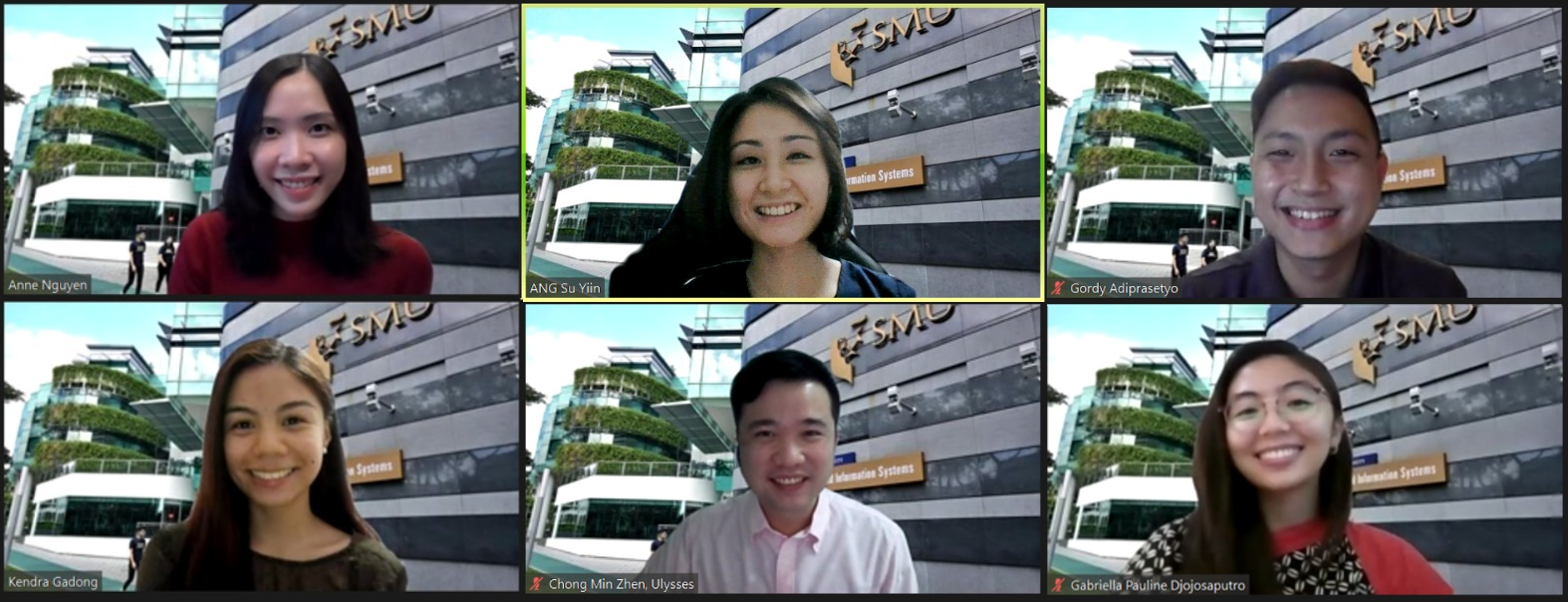
Congratulations to Professor Michelle Cheong (Associate Dean, SCIS Postgraduate Professional Education) and her team of SMU Master of IT in Business (MITB) students - Ulysses Chong Min Zhen, Anne Nguyen, Kendra Gadong, Ang Su Yiin, Gabriella Pauline Djojosaputro and Gordy Adiprasetyo on having their paper (ID 852: Singapore Airlines: Profit Recovery and Aircraft Allocation Models during the COVID-19 Pandemic) accepted for presentation and publication at the 11th Annual International Conference on Industrial Engineering and Operations Management (IEOM) held in Singapore on March 7-11, 2021.

Second row (from left): Kendra Gadong, Ulysses Chong Min Zhen, Gabriella Pauline Djojosaputro
What is the “ID 852: Singapore Airlines: Profit Recovery and Aircraft Allocation Models during the COVID-19 Pandemic” paper about?
The paper is about our project that aims to optimise the aircraft allocation of Singapore Airlines’ fleets according to the post-COVID-19 aviation industry environment through data modelling. Given a certain size of aircraft fleet, the study aims to help airline companies allocate how many aircraft should be used for passengers, cargo, or how many should be put to storage. COVID-19 has severely impacted the global aviation industry, causing many airlines to downsize or exit the industry. For airlines that attempt to sustain their operations, they will need to respond to the increase in passenger and cargo demand, as countries recover slowly from the crisis due to the availability of vaccines.
We built a series of spreadsheet models to first project the COVID-19 recovery rates by countries from 2021 to 2025, then forecast the passenger and cargo demand, using historical data as base figures. Using the financial and operational data, the revenue, expense, and profit can be projected, then an optimisation model is used to determine the optimal number of aircraft to be allocated to passenger and cargo respectively, and the number of aircraft to be put into storage. We applied our models to data extracted from publicly available datasets to obtain insights on the impact of COVID-19 on Singapore Airline’s profit recovery and aircraft allocation.
Our sensitivity analysis shows that Singapore Airline’s profitability and aircraft allocation in 2023 and 2024 will be very sensitive to the vaccine release date. Our models can be applied to another airline, by replacing the financial and operational data, to provide similar insights.
What do you hope to achieve with your paper? What benefits would the paper bring to the society?
We hope to provide a proof-of-concept for a useful optimisation model with the use of Microsoft Excel. This is a tool available to most office workers, thereby democratising the analytics process in organisations that hope to make more data-driven, informed business decisions.
Our work is different from previous works in two ways. Firstly, unlike input-output models which use complex system dynamics concepts and theories and simulation models, or mathematical models that applied agent-based and deep learning models, which are beyond the knowledge and skills of most business executives, our models are built using spreadsheets which are easy to understand, use and modify. Secondly, our models are applied at the company level, for an airline to assess the impact of COVID-19 on its financial and operational aspects to support better decision making, and not at an economic sectorial level to support informed policy decision making.
What is your key takeaway/aspiration after working on this paper?
Through the course of the project, we realised that a wealth of data exists out there, and making data free and accessible to all provides a great avenue to empower decision-making. We also want to see how the model plays out with the latest data regarding cases like the SilkAir merger, together with more complex routing considerations.
How has the MITB programme helped you in the process?
SMU has created in the MITB programme a strong community of like-minded individuals passionate about the use of data and technologies, making every group project not only an exciting challenge but also a fun endeavor. The MITB programme structure enables us to think critically and holistically about how to tackle complex business problems, apply analytics techniques effectively, and communicate the solution to relevant stakeholders in a clear and concise manner. In particular, the MITB course “Spreadsheet Modelling for Decision Making” offers us the opportunity to unleash the full power of Excel modelling. Throughout the course of the project, we encountered various conceptual and technical issues, which were promptly resolved with the help and guidance of Professor Michelle Cheong, as well as extensive library resources. We were glad to find that all MITB instructors have been immensely engaging and caring about student development, making the learning experience here worthwhile.